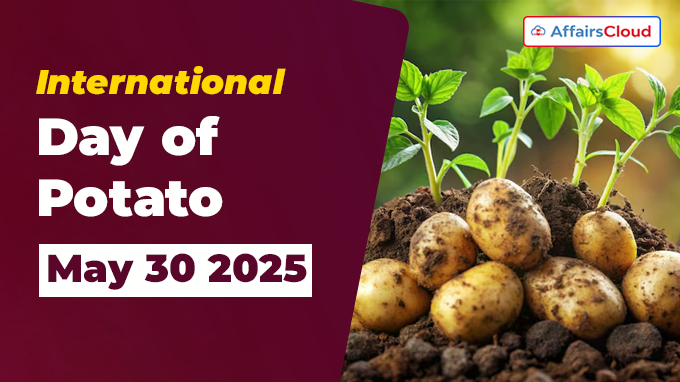 The United Nations (UN’s) International Day of Potato is observed annually across the globe on May 30 to highlight the potato’s (Solanum tuberosum (L.)) crucial role as a global food resource.
The United Nations (UN’s) International Day of Potato is observed annually across the globe on May 30 to highlight the potato’s (Solanum tuberosum (L.)) crucial role as a global food resource.
- It emphasizes its nutritional, economic, environmental, and cultural value, particularly its contribution to income generation for rural families and producers.
- May 30, 2025, marks the 2nd observance of International Day of Potato, significantly coinciding with the 80th anniversary year of the Rome (Italy) based Food and Agriculture Organization (FAO), the UN agency that facilitates the annual event.
2025 Theme:
The theme for the 2025 International Day of Potato, “Shaping history, feeding the future“, acknowledges the potato’s deep historical and cultural significance and its evolving role in today’s global agrifood systems.
Background:
i.The United Nations General Assembly (UNGA) adopted Resolution A/RES/78/123 on December 8, 2023, officially designating May 30 of every year as the International Day of Potato.
ii.The proposal for this observance was championed and submitted to the UNGA by Peru, the potato’s ancestral home.
- Peru’s proposal stemmed from a Resolution adopted by the FAO Conference in July 2023.
iii.The 1st ever International Day of Potato was observed on May 30, 2024.
Significance:
i.Building on Legacy: It provides an opportunity to expand upon the momentum and awareness generated by the 2008 International Year of the Potato.
ii.Combating Global Challenges: It spotlights the potato’s significant contribution to fighting hunger and poverty worldwide and addresses environmental threats impacting agrifood systems.
About Potato:
i.Origin: The potato originated in the Andes region of South America and was introduced to Europe in the 16th century, eventually spreading across the globe.
- It played a vital role in sustaining the Inca civilization and is honoured as the “flower of ancient Indian civilization”.
ii.Versatility: Potatoes can thrive under a wide range of environmental conditions, making them highly suitable for cultivation in regions with limited natural resources.
iii.Global Staple: Approximately two-thirds (2/3) of the world’s population consumes potatoes as a staple food. Nearly 50% of global potato production is used specifically as a household staple or vegetable.
- Globally, potatoes are the third most consumed crop, coming after rice and wheat.
iv.Resilience: The potato is known for its resistance to drought, cold, and barren land, giving it wide adaptability to challenging growing conditions.
v.Nutritional Value: Potatoes are naturally very low in fat (only 0.1% to 1.1%), low in calories, and high in dietary fibre.
Key Facts:
i.Potato consumption in China, India, and Bangladesh collectively accounts for over 40% of the world’s total.
ii.By 2030, global potato production is expected to reach 750 million tons(Mt), a 112% increase. Asia, Africa, and Latin America are projected to produce over 440 million tons, accounting for about 59% of the global output.
2025 Events:
i.To mark the International Day of Potato 2025 on May 30, FAO and the International Potato Center (CIP) (headquartered in Lima, Peru) will co-host a hybrid event entitled “Shaping history, feeding the future” at Rome (Italy).
ii.A five-day exhibition will be held at the FAO headquarters from May 26 to 30, 2025, showcasing the history of the potato, books from the FAO David Lubin Memorial Library, and various potato plants, varieties, and products.
About Food and Agriculture Organization (FAO):
Director-General (DG) – Qu Dongyu
Headquarters – Rome, Italy
Established – 1945




